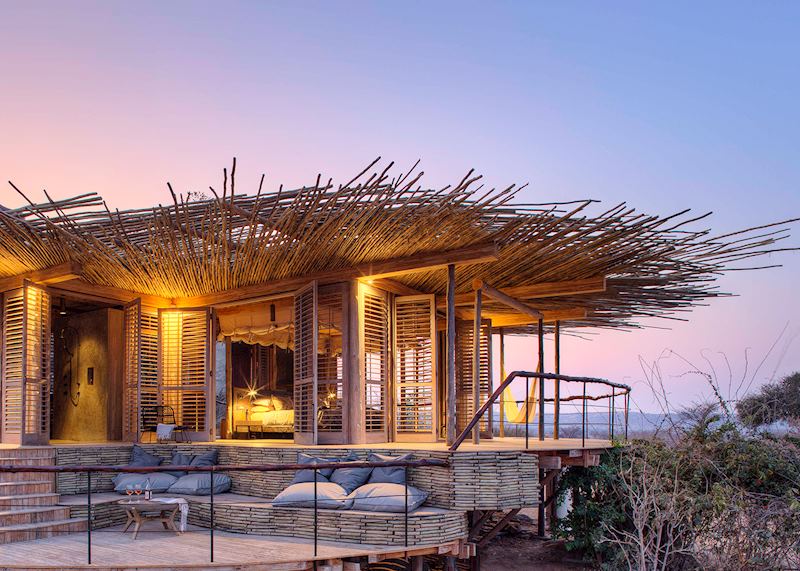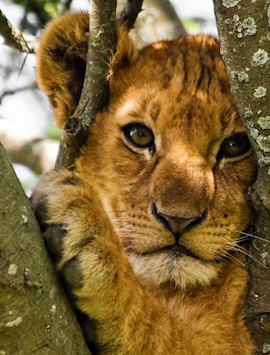By safari specialist Philippa
For many children, the opening scene of The Lion King is their first introduction to landscapes like those of the Serengeti — the vast boulder-dotted plains stretching to the horizon, packed with herds of elephant, prowled by lion, and rumbling with the footsteps of wildebeest. That thrilling sense of familiarity is just one of the reasons I think Tanzania is an ideal destination for family safaris. Here, I’ve outlined some camps and lodges that have rooms, experiences, and price options that are well suited for families with children.
Should you visit northern or southern Tanzania?
Where you go depends on what you’re looking for, but all things being equal, I suggest northern Tanzania for most families. This is the classic safari destination and you’ll be able to choose from a plethora of camps and lodges set up to welcome children of all ages.
Northern Tanzania is a big place, however, so you’ll spend a lot of time driving (albeit in a private vehicle). If you have a youngster who won’t deal well with that much time in a vehicle, you might want a briefer safari in southern Tanzania. There, you can visit two enormous and very different parks with few other visitors, and without the need for road journeys.
Family-friendly lodges & camps in northern Tanzania

Most visits to the northern part of the country follow a path that starts in Arusha, moves on often via Tarangire or Lake Manyara National Park, to the Ngorongoro Crater, and then the Serengeti. This classic route is well populated with excellent lodges in a range of prices.
You’ll have the same driver-guide from the moment you land, including on game drives, making for a more flexible trip. If little legs get restless, your driver can plan in stops. And, if you have a child who’s obsessed with, say, giraffe, they’ll tailor your game drives around ensuring maximum giraffe sightings — something that’s not really feasible in a shared vehicle. (You’re on your own negotiating between siblings, though.)


Where to stay in Arusha: Rivertrees Lodge & Maasai Lodge
If you’re visiting the northern circuit, you’ll almost certainly fly into Arusha, a small city in the northeast near the border with Kenya. There, I suggest decompressing after your international flight at Rivertrees Lodge, which makes an excellent introduction to the country. Its riverside location and views make it beloved among adults, while the pool and excellent food (including a pizza oven) make it ideal for children.
Youngsters might also enjoy the antics of the black-and-white colobus monkeys that live in the trees, especially when they tear through the grounds at mealtimes, trying to snatch a piece of cut fruit.
Another great option for your first few nights is Maasai Lodge, about a two-hour drive north of Arusha, between Mount Kilimanjaro and Mount Meru. As the name suggests, this is Maasai land and the staff are drawn almost entirely from their ranks. Your children can delve deeply into Maasai way of life here and learn traditional skills like (safely) starting a fire with sticks, throwing a spear, and herding goats, as well as joining in with some traditional Maasai dancing.
Where to stay in Manyara National Park: Manyara Green Camp
For your first real taste of the bush, I suggest a few nights at Manyara Green Camp, an intimate camp tucked into a bite-sized national park that shares its name. This isn’t a regular stop for most visitors, so you’ll have a quieter time while getting to enjoy the camp’s wide roster of activities.
This is more adventurous than either of the first two stops I mentioned, with canvas tents on platforms, but you’ll still enjoy amenities like flush toilets. The staff here are exceptionally good with children and you’ll find a variety of activities beyond game drives — a canopy walk, mountain biking, and canoeing on the soda lake. (Visit November to April to see the lake tinged pink with flocks of flamingos.)


Where to stay and what to do near Ngorongoro Crater: Karatu
Ngorongoro Crater cradles a remarkable wealth of wildlife and I love game drives here. That said, there’s not much to do in the crater besides game drives, so some small children may get bored. Instead, I suggest staying in the nearby town of Karatu. It makes a good base for exploring the crater and has plenty of other activities for youngsters who might need a break. You can also take a tuk-tuk tour of the town or visit a nearby Maasai village.
A good family-friendly option in Karatu is Gibb’s Farm. There are 21 guests houses scattered amid the green gardens of this working coffee plantation, with plenty of room for relaxation. The farm offers morning baking classes, a pool overlooking the Great Rift Valley, and guided walks to the nearby Elephant Caves (which is only suitable for teens).
Where to stay in the Serengeti: Kati Kati, Olakira & Kubu Kubu
Literally translated as ‘Endless Plains’, the Serengeti is home to the Great Migration for much of the year. Millions of wildebeest and zebra follow the rains in a clockwise direction across the park and Kenya’s Masai Mara, with predators in their wake. To make the most of the spectacle — and to lighten the load on the land — many of the camps here are mobile, following the gargantuan herds around the plains.
If your family is looking for a safari adventure, I suggest Kati Kati Tented Camp, a no-frills option that strikes a good balance between comfort and authenticity. The family tent is spacious but set right on the ground, with a chemical toilet and a solar-heated bucket shower.
For a slightly more indulgent stay, I suggest Olakira Camp. It’s an authentic tented camp, but you’ll enjoy more creature comforts, including hardwood floors, flush toilets, and three-course meals. Each tent also has a stargazing annex that lets you fall asleep under the Milky Way.
If you want something a bit more indulgent, including a pool, I suggest opting for a permanent camp. And, if you have children, you can’t beat Sayari.
The spacious tents are lofted on wooden platforms and have en suite bathrooms, private verandas, and both indoor and outdoor showers. It’s also home to the Serengeti’s first solar-powered microbrewery, for some adults-only relaxation. The location, near the Mara River, makes it ideal for catching crossings if you visit between July and September.
Family-friendly lodges & camps in southern Tanzania

Lured by the — admittedly dazzling — parks of the north and spotting Big Five, first-time visitors don’t often venture to southern Tanzania. However, it’s an ideal location if you’re looking for a shorter safari, with less driving. The two headline national parks here, Nyerere and Ruaha, offer landscapes that are very different, both from the north and from each other.


Where to stay in Nyerere National Park: Rufiji River Camp & Lake Manze Camp
Though Nyerere Park is one of the largest reserves in Africa, you’ll only encounter a small fraction of the visitors that flock north. Extensive wetlands allow you to watch wildlife like hippo, elephant, and waterbirds from a boat, or try your hand at fishing. This variation often appeals to children who might be bored with too much time in a vehicle.
Right by the entrance to the park, Rufiji River Camp is great for families with children aged 12 and over, who’ll be allowed on walking safaris that open your eyes to the intricacies of the bush. The family suites are two platform tents interconnected with a shared space, with private bathrooms and a plunge pool. In addition to water-based and walking safaris, Rufiji also offers fly camping — your family can head out into the bush and spend the night camping in a temporary dome tent, relishing the splendid isolation.
If you have a child in need of a digital detox, allow me to suggest Lake Manze Camp. A stay here takes you well off the grid — there’s no Wi-Fi at all. Tents are lit by paraffin lamps and come with en suite chemical toilets and warm bucket showers. In exchange for these very simple comforts, you get an authentically wild experience. Animals are free to wander through the camp — staff are on hand to make sure you stay safe — and it’s been known for elephant to drink out of the bucket while guests are showering. (I’ve never had it happen to me, alas.)
Where to stay in Ruaha National Park: Jabali Ridge Camp
Last time I visited Ruaha National Park, my guide explained that even though this is the country’s largest national park, it’s more than 90 percent unmapped. This untamed wilderness is a far cry from the (often busy) Serengeti, where every waterhole and rill has been pinpointed for more than a century.
The park’s patchwork of densely forested hills, baobab stands, rugged plateaus, and sand rivers is the only place where the biomes of southern and eastern Africa mingle. You might see adapted subspecies from both regions like greater and lesser kudus — antelope with huge swirly horns. That said, the park is best known for its dense elephant population.
Because this is such a special place, I’m going to suggest a lodge that’s purely indulgent: Jabali Ridge. Eight opulent villas — interlinked by graceful wooden bridges — perch on stilts atop a rocky escarpment, giving them sweeping views of a sun-bleached plain dotted with palms and baobabs. You can enjoy an infinity pool, spa, and exquisite meals. And, of course, twice-daily game drives to spot some of the abundant wildlife that roams the area.
Best time for a family safari in Tanzania

I suggest visiting northern Tanzania during the green season, between November and March. The weather is mostly comfortable, though you might encounter some short, sharp rainstorms in the afternoons. What’s more, this is calving season — who doesn’t love a baby animal? It’s also less busy than July to September, when most people visit. If you do want to visit during the summer break, I suggest booking at least nine months (preferably a whole year) in advance — family rooms tend to get snapped up early. In southern Tanzania, I suggest visiting between June and October.
Read more about trips to Tanzania
Start thinking about your experience. These itineraries are simply suggestions for how you could enjoy some of the same experiences as our specialists. They're just for inspiration, because your trip will be created around your particular tastes.
View All Tours in Tanzania



